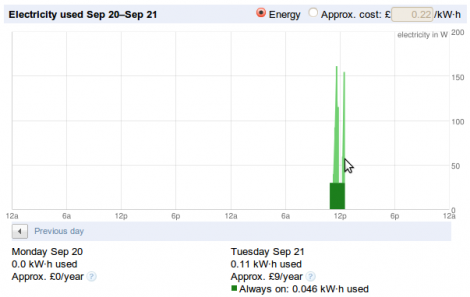
[Dodgy] wrote in to talk about his power meter data harvesting programs. This uses the same hardware by CurrentCost as the hack we looked at over the weekend but [Dodgy’s] implementation is different. It’s separated into two parts, the first is a webserver written in C that harvests the data and makes it available at an address on the network, the second is written in Perl to format and upload data to Google PowerMeter.
The C program serves data on a configurable port, defaulting to 3090. All of the data can be accessed in one line of code by loading http://127.0.0.1:3090, or individually with subdirectories like /watts, /time, or /tempr. From there you can do what you want with the data. The second part of [Dodgy’s] suite is a Perl script that polls the C server and sends the data to your Google account.
One thing that interests us is his comment that you should be able to compile the server side C code for an embedded device. It would be a nice energy savings to be able to upload data regularly without a PC running constantly.
















“One thing that interests us is his comment that you should be able to compile the server side C code for an embedded device.”
Hackers start your Dockstars.
http://www.theenergydetective.com/ted-5000-c
far more accurate as it has TWO reading points, plus is ethernet already AND does a whole lot more.
and are ready to buy in the USA.
but that ted 5000-c is much more expensive. are there any other hardware similar to CurrentCost. they don’t ship to brazil and the powersave from EUA charges too much for it
Does anyone know of comparable products sold in the US?
possible to put the webserver on a DD-WRT install? I guess the data would be best put in a proper database like mysql or similar
You should be able to run it on a WRT distro yes, as its just C code to compile with very little deps…
As for the proper DB, why would you want to run mysql on a WRT install? You could use sqlite as its a smaller footprint, though rrdtool could also store the values (and create you graphs as well).
CurrentCost have produced just such an Embedded device more details including some pictures here http://hotzone.org.uk/currentcost-bridges-arrive-with-customers/
I know someone has already been able to install the arduino bootloader, and some example networking code.
Reza, You can get CurrentCost products in the USA see here for more details
http://currentcost.net/
There was a spectacular talk at DEFCON put on by the folks from http://pleaserobme.com/ about the relative (un)intelligence of broadcasting your power usage stats to the world with services like foursquare, powermeter, tweet-a-watt, etc. If you like the idea of broadcasting your non-presence to the world, best to accept the risk of being pwnd.
Until there are more utilities or cheaper devices in the US, this kinda stuff won’t take off. I’d love to use Google meter or a device to figure out the most expensive part of our daily electrical usage. But TED is ridiculously expensive. CurrentCost is better. Is it so hard to make a meter that will do this? Hell, electric companies already collect data by radio, why not make it 802.11 and let homeowners pull it as well?
Is it just me or are the first 2 paragraphs of this article saying EXACTLY the same thing?
Microchip has special purpose mcro controllers to do that
I haven’t tested one personally. But, comments from some trusted sources on an electric vehicle list I frequent mentions that the CurrentCost meters don’t track voltage or power factor — they measure only amperage — so the kw readings are much less accurate than a meter like the TED that tracks voltage, amperage and power factor.
I was excited to first see the CC as a lower cost alternative, but that inaccuracy is a dealbreaker for me. Back to saving up for a TED..
@DCinNM That’s already done, Google “ZigBee” the problem with it is that all you get is a cumulative every 10minutes Vs, second by second real-time feedback with TED. Also CC does not measure voltage, so it’s assuming your voltage is 120/240 which is just not true most of the time, your voltage will fluctuate with load in your house AND considering that you also share your transformer with 3-4 other houses your voltage will fluctuate with loads changing in their house too. With voltage possibly fluctuating as much as 10% there is your error range.
I bought a TED5000 several months ago and was initially very impressed, until it stopped synching to NTP, became inaccessible over my LAN, and became about as useful as one of those hand-warmer pouches if it were tethered to a wall. I did an RMA, but had the same problems with the new unit. I was able to return the entire device. I wish you luck with it, but make sure to save your receipt in case it acts up. If you can get it working continuously, it’s really cool. Mine worked for a couple of days. I did learn that if I want to save $, I should turn off lights and air conditioners when not necessary. I also learned that I don’t need this gizmo in order to do that.
This post and the previous one about the CC meter got me searching about ways to do this with an Arduino. I found this: http://openenergymonitor.org which I hadn’t seen before. I might have to make one.
For anyone in the UK IAM’s (Individual Appliance Modules) are now available to order
More info here:
http://hotzone.org.uk/currentcost-iams-available/